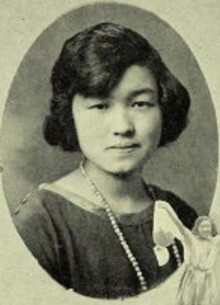Fumiko Yamaguchi
Fumiko Yamaguchi | |
|---|---|
 Fumiko Yamaguchi, from the 1925 yearbook of Barnard College | |
| Born | 25 May 1903 Japan |
| Died | 8 January 1987 Los Angeles, California, US |
| Other names | Fumiko Y. Amano |
| Occupation(s) | Physician, advocate for reproductive health |
| Relatives | Jean Shinoda Bolen (niece) |
Fumiko Yamaguchi Amano (25 May 1903 – 8 January 1987) was a Japanese-born physician and advocate for reproductive health. She and her husband were both educated in the United States, and founded the Japan Birth Control Institute in Tokyo after World War II.
Early life and education[edit]
Fumiko Yamaguchi was born in Tokyo, the eldest daughter of Minosuke Yamaguchi[1] and Yuki Sasaki Yamaguchi. She was raised in Ohio while her father was attended medical school, and in New York when her father was a physician there. She graduated from Barnard College in 1925,[2] and completed a medical degree at Yale School of Medicine.[3] While at Yale, she was coauthor of a biochemistry article, "Factors Influencing the Distribution and Character of Adipose Tissue in the Rat" (1930).[4]
Her sisters Aiko Yamaguchi (Takaoka) and Megumi Yamuguchi (Shinoda) also attended Barnard College.[5] Two of her brothers and her sister Megumi also became physicians.[1][6] Psychiatrist Jean Shinoda Bolen is Yamaguchi's niece.[7]
Career[edit]
Amano had a clinic in Los Angeles in the early 1930s.[8] She practiced obstetrics and gynecology in Tokyo from 1938 to 1945.[9] After World War II,[10][11] she and her husband ran a clinic,[8] led the Japan Birth Control Institute,[12][13] and co-edited the Japan Planned Parenthood Quarterly.[14][15] She was official hostess of the Fifth International Conference on Planned Parenthood, held in Tokyo in 1955.[16] She was author of a pamphlet, "Family Planning in Japan" (1955).[17]
Amano and her husband moved to Los Angeles in the late 1950s, and she reopened her Los Angeles clinic in 1959.[8] Also in 1959, she spoke on "The Changing Economic Status of the Women of Japan" to Japanese-American women in Los Angeles.[18] In 1962, she and her husband opened a new office together in the city's Crenshaw neighborhood.[19] She was still working as a doctor and teaching until shortly before her death in 1987.[20]
Personal life[edit]
Fumiko Yamaguchi married fellow Japanese physician Kageyasu Wat Amano in Arizona in 1934.[21] They had two children.[22] She became a United States citizen in 1964. She died from a heart attack in 1987, aged 84 years, in Los Angeles.[20]
References[edit]
- ^ a b "Minosuke Yamaguchi (death notice)". The Los Angeles Times. 1956-04-25. p. 42. Retrieved 2021-11-02 – via Newspapers.com.
- ^ Barnard College, Mortarboard (1925 yearbook): 168.
- ^ Amano, Fumiko (1955). Family planning movement in Japan. Foreign Affairs Association of Japan.
- ^ Reed, Lucille L.; Yamaguchi, Fumiko; Anderson, William E.; Mendel, Lafayette B. (1930). "Factors Influencing the Distribution and Character of Adipose Tissue in the Rat". The Journal of Biological Chemistry. 87: 147–174. doi:10.1016/S0021-9258(18)76898-1.
- ^ "Letters from Japan". Barnard Alumnae. 74: 6. Spring 1985.
- ^ "Megumi Yamaguchi Shinoda M.D. Obituary". Los Angeles Times. May 8, 2007. Retrieved 2021-11-02.
- ^ "Obituary for Megumi Yamaguchi Shinoda, M.D." Fukui Mortuary, Inc. Retrieved 2021-11-02.
- ^ a b c "Dr. Fumiko Amano Reopens Practice after 25 Years". Shin Nichibei. April 17, 1959. p. 1. Retrieved November 2, 2021 – via California Digital Newspaper Collection.
- ^ Sanger, Margaret (2016-10-01). The Selected Papers of Margaret Sanger, Volume 4: Round the World for Birth Control, 1920-1966. University of Illinois Press. pp. 420, note 5. ISBN 978-0-252-09880-2.
- ^ Beech, Keyes (1947-08-09). "Japan's Population Pushes Rapidly Up". Honolulu Star-Bulletin. p. 8. Retrieved 2021-11-02 – via Newspapers.com.
- ^ Oakley, Deborah (1978). "American-Japanese Interaction in the Development of Population Policy in Japan, 1945-52". Population and Development Review. 4 (4): 617–643. doi:10.2307/1971729. ISSN 0098-7921. JSTOR 1971729.
- ^ Hardacre, Helen (1999-03-10). Marketing the Menacing Fetus in Japan. University of California Press. p. 60. ISBN 978-0-520-21654-9.
- ^ Steiner, Jesse F. (1953-03-01). "Japan's Post-war Population Problems". Social Forces. 31 (3): 245–249. doi:10.2307/2574222. ISSN 0037-7732. JSTOR 2574222.
- ^ "News and Announcements". American Sociological Review. 15 (5): 676–680. October 1950. ISSN 0003-1224. JSTOR 2086928.
- ^ "Japan's Birth Control Paper". The Sydney Morning Herald. 1950-04-14. p. 1. Retrieved 2021-11-02 – via Newspapers.com.
- ^ Hajo, Cathy Moran (January 2013). "Who's who at the Fifth International Conference on Planned Parenthood?". Margaret Sanger Papers Project. Retrieved 2021-11-01.
- ^ Amano, Fumiko (1955). Family planning movement in Japan. Foreign Affairs Association of Japan.
- ^ "Dr. Amano Talk to Post 9938 Auxiliary Set". Shin Nichibei. June 2, 1959. p. 1. Retrieved November 2, 2021 – via California Digital Newspaper Collection.
- ^ "Amano & Amano (advertisement)". California Eagle. 1962-08-30. p. 2. Retrieved 2021-11-02 – via Newspapers.com.
- ^ a b "In Memoriam". Barnard Alumnae. 76: 27, 29. June 1987 – via Internet Archive.
- ^ "Cosmopolitan List Arrives on Taiyo Maru". The Honolulu Advertiser. 1934-10-22. p. 2. Retrieved 2021-11-02 – via Newspapers.com.
- ^ "Population Control in Japan". The San Francisco Examiner. 1956-06-13. p. 23. Retrieved 2021-11-02 – via Newspapers.com.
External links[edit]
- Deborah Oakley, "American-Japanese Interaction in the Development of Population Policy in Japan, 1945-52" Population and Development Review 4(December 1978): 617-643.
